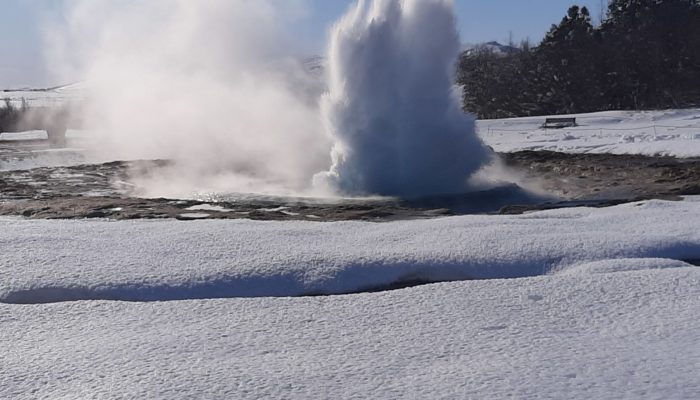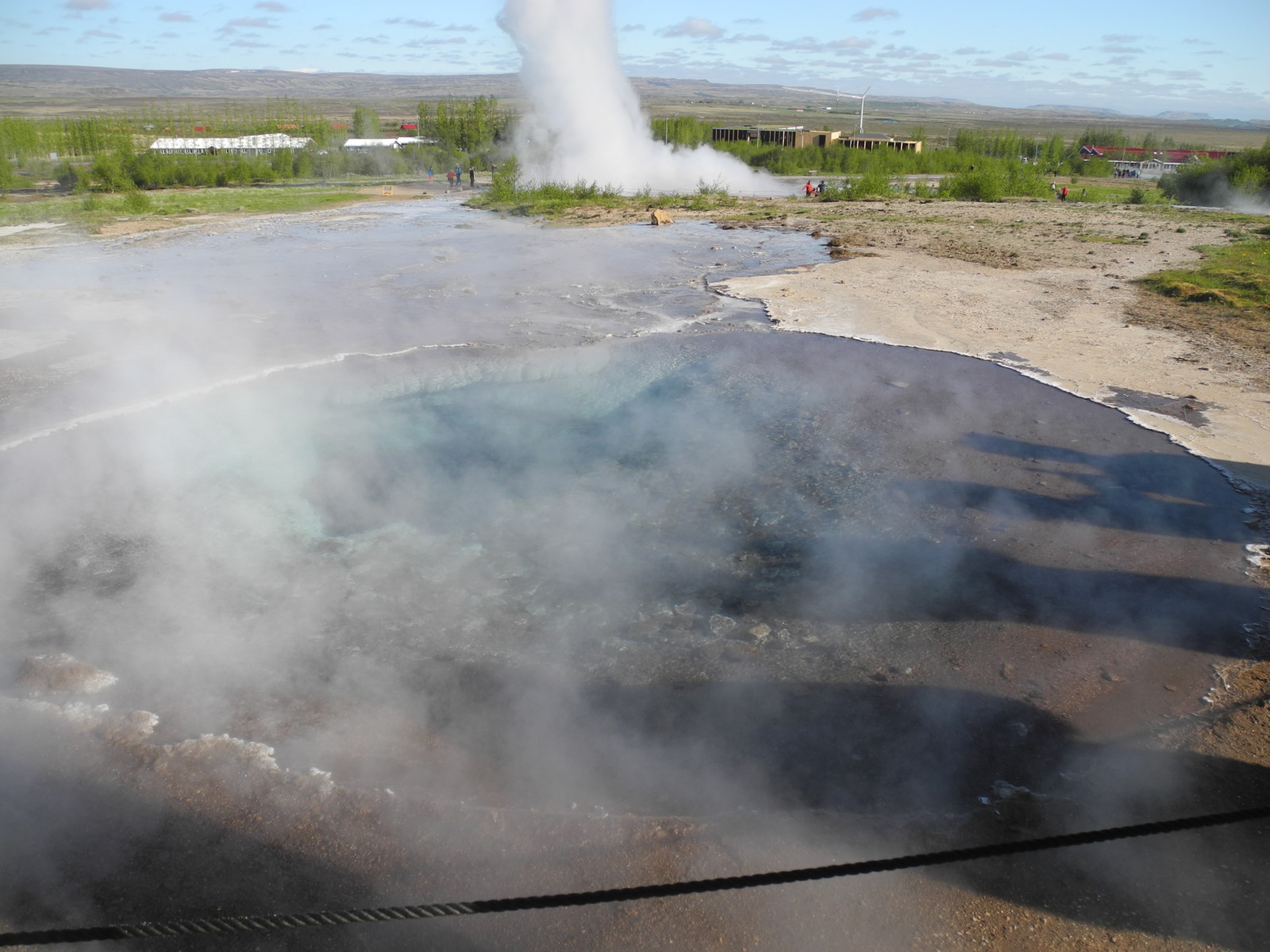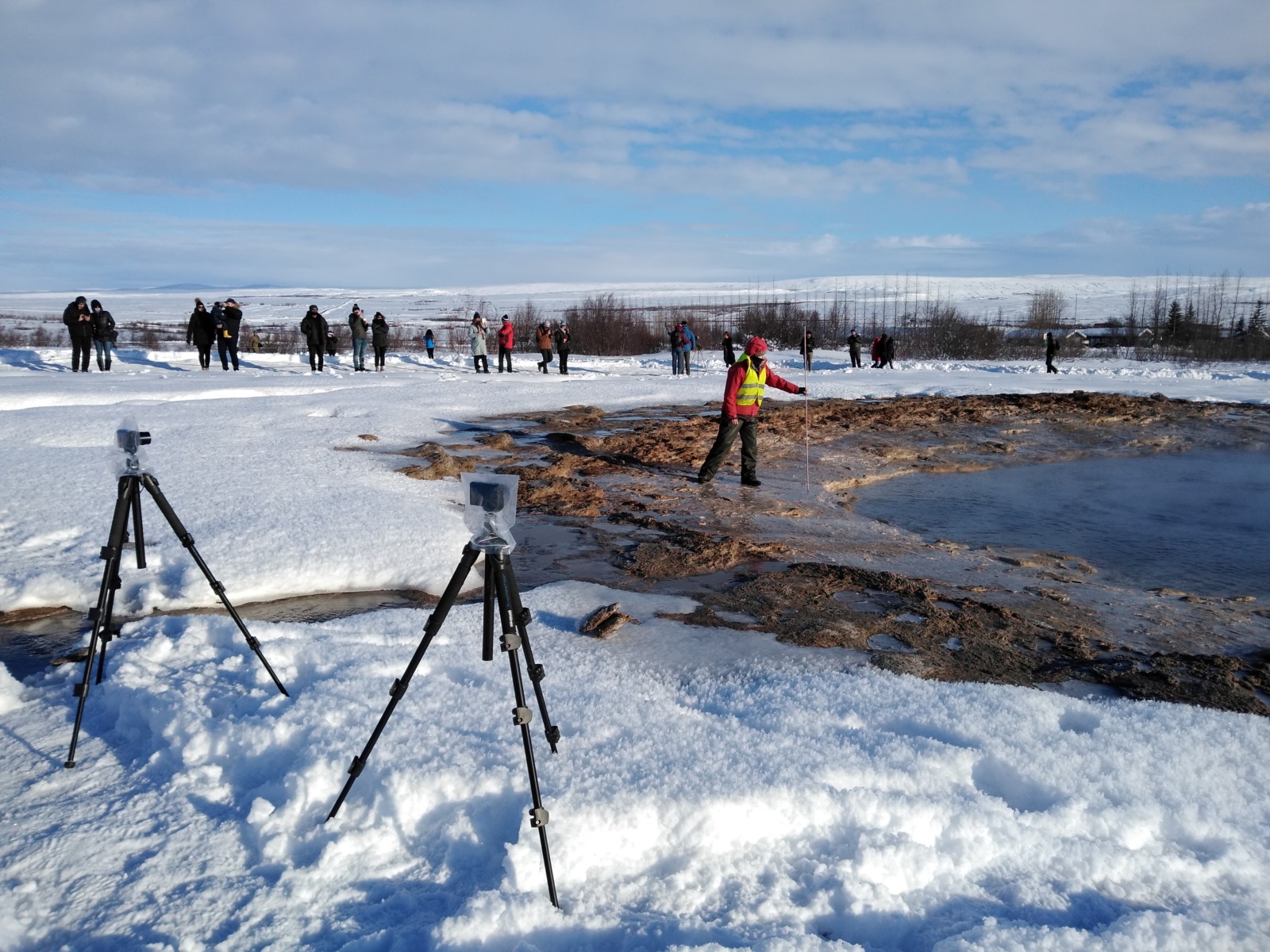
I was fascinated and excited on my first trip to Iceland in August 2010; just a few months after the eruption of Eyjafjallajökull that affected the air traffic across Europe for a few days. Besides these dangerous volcanoes, the Icelandic landscape is beautiful, rough, wide and impressive with elements such as water and ice interacting directly at some locations. Part of this trip was, of course, a stop in an area with steam, water-filled pots with boiling water and two geysers. One of them erupts quite rarely – only a few times per year, whilst the other one erupts every few minutes. So of course, I stood there like everyone else, with a camera in my hands wondering when the next eruption might come and hoping to take a nice photo.
I came back in January 2013 as a PhD student with my valued colleague Kristin Vogfjörd (Icelandic Meteorological Office), now equipped with a bunch of seismometers determined to measure the eruptions of Strokkur with seismic instruments. If you have ever been to Iceland in January, you will know that it was pretty cold, full of snow and pretty dark quite soon. So, after a few long hours in the field, we decided to uninstall and leave. In the end, I never found time to analyze this dataset in detail, partly also because we were too optimistic on the strength of the signal. It turned out that at 200 m distance, you mainly record the passing cars, not the geyser. 😉
Another seven years and at least 7 trips to Strokkur later, I can tell you that you will wait about 3.7 minutes for the next eruption. However, sometimes the geyser erupts twice in a row and then you have to wait 6.2 minutes. If you are lucky you will even be able to see an eruption with three, four, five or six water fountains in a row. I ended up working on a 1-year seismic dataset collected by colleagues at GFZ from 2017/18 (Eibl et al. 2020b1) with two students and created and published an eruption catalogue containing more than 73,000 eruptions of Strokkur (Eibl et al. 20192). Based on this catalogue it was easy to calculate the average time after e.g. single eruptions (Eibl et al. 2020a3).
Besides this very regular behaviour, there are of course single eruptions with unusually short or extremely long waiting times. I spend another week at Strokkur in March 2020 where we had beautiful sunshine, rain, very strong wind, relatively warm, very cold days and a snow cover in the second half of the week. We moved our instrument every day, independent of the weather, trying not to slip on the icy ground. Hence, we spend 4 hours in the field on a day with very strong wind. It was obvious on the day that Strokkur erupted less often. Since Strokkur is a geyser with a water pool on the surface, more heat is lost if the wind is strong or the temperature is very low. We will need to investigate this in more detail.
In order to protect the tourists from the steam and hot water ejected by the geyser, an area of 10 to 30 m around the geyser is locked. We found that people standing west of the geyser at about 10 m distance can actually feel the ground rumbling and moving beneath their feet. They most likely stand on top of the bubble trap that enables the regular hot water fountain (Eibl et al. submitted4). A heat source at a few kilometres depth heats water, that rises into a bubble-trap. In this bubble-trap gases can accumulate until there is too much gas and it escapes into the conduit. This system might look like the siphon in your bathroom. These large escaping bubbles either implode at depth or reach the surface and eject a water fountain up to 50 m into the air.
What now? Since Strokkur has now become a tourist attraction with probably a few thousand visitors per year, it was quite difficult for us to mark eruptions reliably in the 2017/18 dataset. From 10 to 18 am local time there is a lot of noise from tourists walking in the area that hides eruptions of Strokkur in our seismic recordings. In the first version of our catalogue we, therefore, excluded eruptions between 10 am and midnight for most of the year. Now we attempt to add these as well, by using more narrow filters and automatic picking techniques. Our catalogue now comprises more than 90,000 eruptions which will be a unique basis for a detailed comparison with temperature, wind, air pressure etc.
Since geysers with a heat source, bubble trap and conduit are similar to volcanoes with hot magma, magma chamber and conduit we might also be able to transfer some knowledge in the future. We were also lucky enough to reinstall 3 seismometers near Strokkur in March 2020 shortly before the Corona lockdown. These seismometers still record and are checked every few months by our valued colleagues at ISOR, Iceland. My student is now working on the amazingly clear dataset we collected this summer when due to corona restrictions only a few tourists affected our measurements. I am looking forward to my next trip to Iceland in 2021 to collect my seismometers and watch the beautiful interaction of snow, hot water and eruptions of my old, fascinating friend, the erupting geyser.
References
-
- 1 Eibl, E. P. S.; Walter, T.; Jousset, P.; Dahm, T.; Allahbakhshi, M.; Müller, D.; Hersir, G.P. (2020b): Strokkur_1yr. GFZ Data Services. Other/Seismic Network. DOI:10.14470/2Y7562610816
- 2 Eibl, E. P. S., Jousset, P., Dahm, T., Walter, T. R., Hersir, G. P., Vesely, N. I. K. (2019) ‘Seismic experiment at the Strokkur Geyser, Iceland, allows to derive a catalogue of over 70,000 eruptions.’ GFZ Data Services. http://doi.org/10.5880/GFZ.2.1.2019.005
- 3 Eibl, E. P. S., Hainzl, S., Vesely, N. I. K., Walter, T. R., Jousset, P., Hersir, G. P., Dahm, T., (2020a) Eruption Interval Monitoring at Strokkur Geyser, Iceland, Geophysical Research Letters, 47, DOI: 10.1029/2019GL085266
- 4 Eibl, E. P. S., Müller, D., Walter, T. R., Allahbakhshi, M., Jousset, P., Hersir, G. P., Dahm, T., (in review) Eruptive Cycle and Bubble Trap of Strokkur Geyser, Iceland, JGR: Solid Earth, Preprint DOI: 10.1002/essoar.10504076.1
- 1 Eibl, E. P. S.; Walter, T.; Jousset, P.; Dahm, T.; Allahbakhshi, M.; Müller, D.; Hersir, G.P. (2020b): Strokkur_1yr. GFZ Data Services. Other/Seismic Network. DOI:10.14470/2Y7562610816
This blog post was written by Eva Eibl
with edits from ECS representative Maria Tsekhmistrenko


